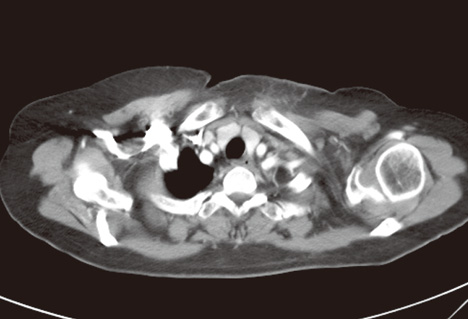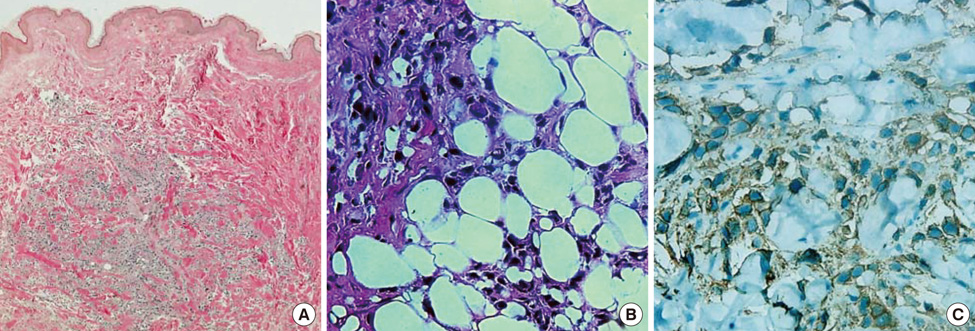J Breast Cancer.
2011 Dec;14(4):340-344. 10.4048/jbc.2011.14.4.340.
Acupuncture-Related Rapid Dermal Spread of Breast Cancer: A Rare Case
- Affiliations
-
- 1Comprehensive Breast Cancer Center, Department of Medical Research, Changhua Christian Hospital, Changhua, Taiwan. darren_chen@cch.org.tw
- 2Department of Surgical Medicine, Erlin Branch of Changhua Christian Hospital, Changhua, Taiwan.
- KMID: 2175739
- DOI: http://doi.org/10.4048/jbc.2011.14.4.340
Abstract
- Many ethnic Chinese patients seek second or adjuvant alternative therapies after breast cancer is diagnosed. Chinese herbs and acupuncture are the most popular methods in East Asia. We present a case of acupuncture manipulation-related cutaneous spread that no literature reported before. Post-acupuncture cutaneous spread was noted in a 54-year-old woman with left neck lymph node recurrence after complete surgery, chemotherapy and radiotherapy treatment. The results of chest computed tomography and skin biopsy showed the metastatic breast cancer in the dermis. Six courses of paclitaxel and gemcitabine followed by trastuzumab were given as therapeutic chemotherapy. The neck mass and cutaneous lesions subsided after 2 courses of chemotherapy. Direct puncture of a metastatic lymph node might increase the incidence of tumor spread on the skin. Therefore, despite the efficacy of complementary and alternative medicine, its safety and possible side effects should be more emphasized.
Keyword
MeSH Terms
-
Acupuncture
Antibodies, Monoclonal, Humanized
Asian Continental Ancestry Group
Biopsy
Breast
Breast Neoplasms
Complementary Therapies
Deoxycytidine
Dermis
Far East
Female
Humans
Incidence
Lymph Nodes
Middle Aged
Neck
Paclitaxel
Punctures
Recurrence
Skin
Thorax
Trastuzumab
Antibodies, Monoclonal, Humanized
Deoxycytidine
Paclitaxel
Figure
Cited by 1 articles
-
Hemoperitoneum Resulting From Injuries to Liver with a Benign Vascular Tumor During Acupuncture: A Case Report
Sohyung Park, Han Young Lee
Korean J Leg Med. 2012;36(1):107-110. doi: 10.7580/KoreanJLegMed.2012.36.1.107.
Reference
-
1. Cui Y, Shu XO, Gao Y, Wen W, Ruan ZX, Jin F, et al. Use of complementary and alternative medicine by chinese women with breast cancer. Breast Cancer Res Treat. 2004. 85:263–270.
Article2. Chen Z, Gu K, Zheng Y, Zheng W, Lu W, Shu XO. The use of complementary and alternative medicine among Chinese women with breast cancer. J Altern Complement Med. 2008. 14:1049–1055.
Article3. DiGianni LM, Garber JE, Winer EP. Complementary and alternative medicine use among women with breast cancer. J Clin Oncol. 2002. 20:18 Suppl. 34S–38S.4. Ernst E, Cassileth BR. The prevalence of complementary/alternative medicine in cancer: a systematic review. Cancer. 1998. 83:777–782.
Article5. Johannessen H, von Bornemann Hjelmborg J, Pasquarelli E, Fiorentini G, Di Costanzos F, Miccinesi G. Prevalence in the use of complementary medicine among cancer patients in Tuscany, Italy. Tumori. 2008. 94:406–410.
Article6. Lu W, Matulonis UA, Doherty-Gilman A, Lee H, Dean-Clower E, Rosulek A, et al. Acupuncture for chemotherapy-induced neutropenia in patients with gynecologic malignancies: a pilot randomized, sham-controlled clinical trial. J Altern Complement Med. 2009. 15:745–753.
Article7. Balk J, Day R, Rosenzweig M, Beriwal S. Pilot, randomized, modified, double-blind, placebo-controlled trial of acupuncture for cancer-related fatigue. J Soc Integr Oncol. 2009. 7:4–11.8. Bao T. Use of acupuncture in the control of chemotherapy-induced nausea and vomiting. J Natl Compr Canc Netw. 2009. 7:606–612.
Article9. Johnston MF, Hays RD, Hui KK. Evidence-based effect size estimation: an illustration using the case of acupuncture for cancer-related fatigue. BMC Complement Altern Med. 2009. 9:1.10. Fitzal F, Sporn EP, Draxler W, Mittlböck M, Taucher S, Rudas M, et al. Preoperative core needle biopsy does not increase local recurrence rate in breast cancer patients. Breast Cancer Res Treat. 2006. 97:9–15.
Article11. Knight R, Horiuchi K, Parker SH, Ratzer ER, Fenoglio ME. Risk of needle-track seeding after diagnostic image-guided core needle biopsy in breast cancer. JSLS. 2002. 6:207–209.12. King TA, Hayes DH, Cederbom GJ, Champaign JL, Smetherman DH, Farr GH, et al. Biopsy technique has no impact on local recurrence after breast-conserving therapy. Breast J. 2001. 7:19–24.
Article13. Youngson BJ, Rosen PP. Dershaw DD, editor. Epithelial displacement in surgical breast specimens after needling procedures. Interventional Breast Procedures. 1996. 1st ed. London: Churchill Livingstone;162–166.14. Sauer T, Myrvold K, Lømo J, Anderssen KY, Skaane P. Fine-needle aspiration cytology in nonpalpable mammographic abnormalities in breast cancer screening: results from the breast cancer screening programme in Oslo 1996-2001. Breast. 2003. 12:314–319.
Article15. Smith EH. The hazards of fine-needle aspiration biopsy. Ultrasound Med Biol. 1984. 10:629–634.
Article
- Full Text Links
- Actions
-
Cited
- CITED
-
- Close
- Share
- Similar articles
-
- Review of Acupuncture Related Death Cases with a Case Report: Acupuncture Shock?
- Radiological Considerations in Diagnosing Angiosarcoma Associated With Lymphedema Following Breast Cancer Surgery
- A Case of Alopecia Neoplastica Metastasis from Breast Carcinoma
- Hemopericardium Following Acupuncture
- Invasive Paget’s Disease of the Breast: A case Report





